If you are looking to use nutrition facts labels in a way that supports your healthy eating goals, check out this article. Reading nutrition facts can be overwhelming! I go over 5 tips for reading nutrition facts labels.
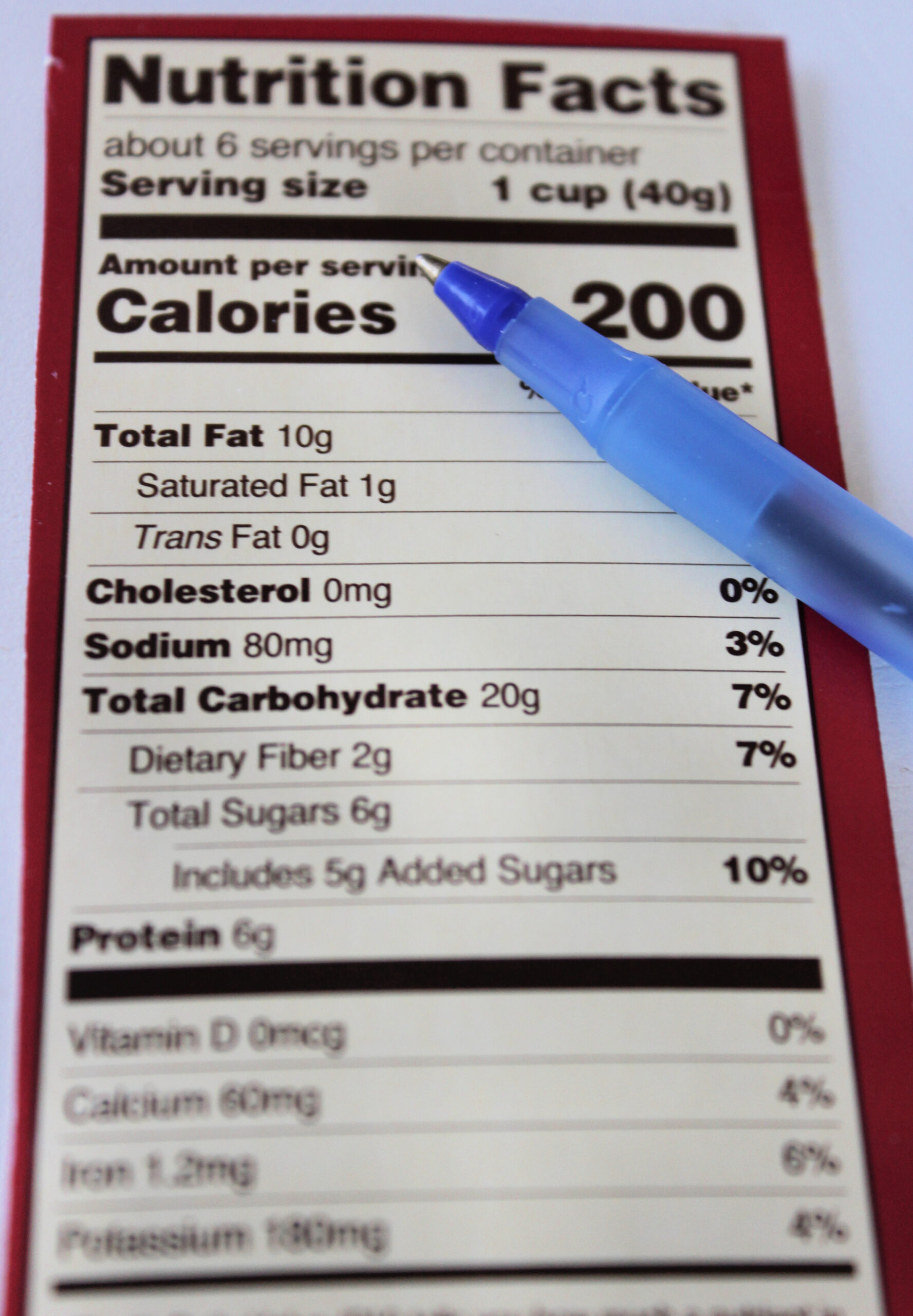
Nutrition Facts Label Reading Tip #1. Look at the serving size
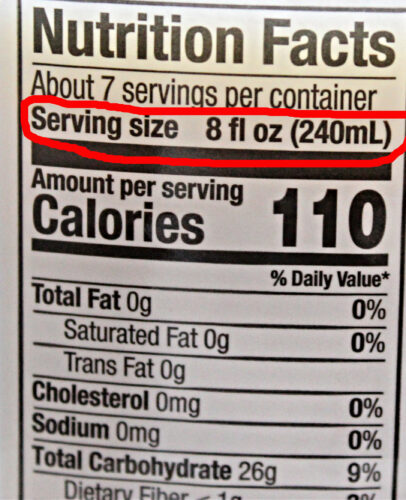
When you are looking at nutrition facts for a food, remember that the information is specific to the serving size for that food. In the label above you can see that the serving size for this orange juice is 8 fl oz (or 240 mL which is also one cup). So the amount of calories, fat, cholesterol, sodium, carbohydrate, etc. are all based on 8 fluid ounces of orange juice. If you drink more or less than 8 fluid ounces, the amount of all of those nutrients you receive will be different. So for example, if you drink 16 fluid ounces, you would receive double the calories, double the carbohydrate, and double everything else on the nutrition facts label.
Serving size is also important to consider when you compare similar food products. For example, you may look at two different cereals and think that one has far less sugar than the other. But this may not be true if the serving sizes are different. I have seen cereals with a serving size of 1/2 cup and other cereals with a serving size of 1 and 1/2 cups. This can make comparing products difficult.
How serving sizes are measured
You will also want to pay attention to what measurement that product is portioned out in. This orange juice is measured by fl oz, which means fluid ounces. Other products may be measure in cups or tablespoons which are all measurements of volume. You will also see some product servings measured by grams which is a measurement of weight. Weight can be used if you use a food scale to portion out your food.
I have seen many people get confused when a product serving size is measured in weight with grams. They may confuse this with grams of carbohydrate or grams of some other nutrient they are focusing on. When you see g (as in grams) next to serving size, that is talking about the serving size in weight. For an example see the product nutrition facts label below. The serving size for this food can be measured by volume (2/3 cup) or by weight (30 g).
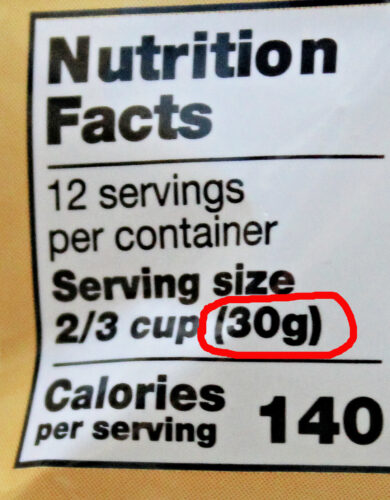
Nutrition Facts Label Reading Tip #2. Look at the number of servings in the package/container
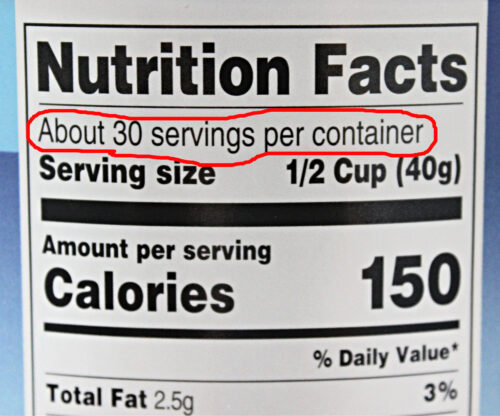
There may be some products that look like one serving, but may actually have more than one serving in them. Always check number of servings in a container or package of food before assuming it is one serving. The example above is a large container of oats. This container has about 30 servings in it. While this product obviously has more than one serving in it, others may not be so obvious. Products that often have more than one serving (but may not look like it) include bottled drinks that appear to be individual sizes, and packaged snack foods. If a bottled drink has 2.5 servings in it and you drink the whole bottle, you will need to multiply each nutrient by 2.5. This will tell you the actual amount of each nutrient you are receiving from drinking the whole bottle.
Nutrition Facts Label Reading Tip #3. Focus on what is important to you
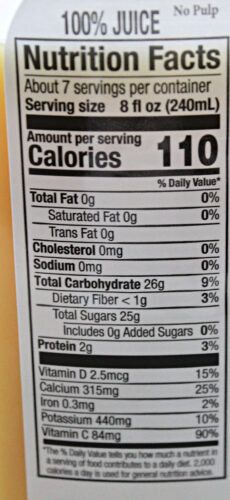
Nutrition facts labels have a lot of information on them! It can be overwhelming to look at them and try to make decisions based on what you are looking at. I think it is helpful to first decide what nutrients are most important to you. Based on your health journey at this point, what numbers matter the most?
If you have diabetes and need to count carbohydrates, then the amount of carbohydrate per serving may be the most important number. Or if you have congestive heart failure and need to avoid salt, sodium content may be your primary focus. Perhaps you need to maximize protein intake for healing, then you can focus on the amount of protein in a product. Individuals with high cholesterol may need to consider the amount of saturated fat in each food they eat. Or if you have anemia and need to increase your iron intake, then the amount of iron in your foods may be the most important nutrient to you.
When you become more comfortable with using nutrition facts labels, you will be able to look at more than one nutrient of interest at a time. Practice reading labels to become more comfortable and you will be a nutrition facts label reading pro in no time.
Nutrition Facts Label Reading Tip #4. Consider the food you are eating
When you are looking at nutrition facts labels, consider if you are looking at a snack food, an entrée, a drink or dessert. A serving of an entrée may seem to have a whole lot of, well, everything. But keep in mind that entrée foods are meant to be full of nutrition and are meant to satisfy hunger for hours after you eat. Additionally, you are likely going to pair the entrée food with other lower calorie side dishes such as a vegetable or fruit. We still want to make healthy choices with entrees, but when you compare their nutrients to a serving of a granola bar, or some other snack food, it should have more calories, fat and carbohydrate.
So keep in mind what type of food you are eating. I would only compare it to foods in the same category when you are trying to choose healthier options. For example, I would only compare an entrée to other entrées or snack foods to other snack foods.
Nutrition Facts Label Reading Tip #5. Don’t forget the ingredient label!

While the ingredient label is not technically part of the nutrition facts label, I think it is just as important to look at. I believe that they come side by side for a reason.
Reading ingredient labels can be so useful when you have a food allergy you need to avoid. It is also helpful if you must eliminate gluten from your diet due to having celiac disease. It is also very helpful for those that want to avoid certain additives or preservatives. For example, ingredient labels inform us of trans fats, high fructose corn syrup, artificial food colors or artificial flavors. Likewise, some people may need to avoid certain ingredients that just don’t agree with their digestive tract. This can include things like chicory root or sugar alcohols for example.
Ingredients are listed in descending order by weight of ingredients. So the first ingredient that is listed contributes the most weight to the product. So for example, the ingredient that contributes the most weight to the product above is brown sugar. After that corn meal contributes the second most amount of weight to the food and so on.
By combining both nutrition facts and ingredient labels, we can really make informed decisions on what we are eating.
Bonus Nutrition Facts Reading Label Tip
I hope these 5 tips for reading nutrition facts labels has been helpful. And here’s a bonus tip (or two). Many fresh, whole foods do not have nutrition facts on them. You can look these foods up on a nutrient database such as the USDA FoodData Central. Additionally, if you eat out often or regularly don’t forget that many chain restaurants have nutrition facts available. You can go to their website and look for their nutrition facts online. This is also a great way to plan ahead if you know you will be going to a restaurant but want to eat healthier.
Leave a Reply